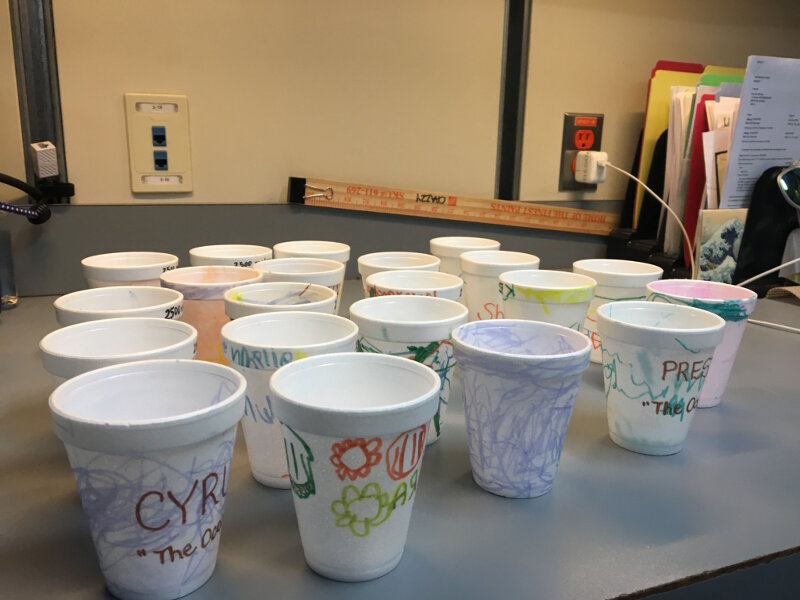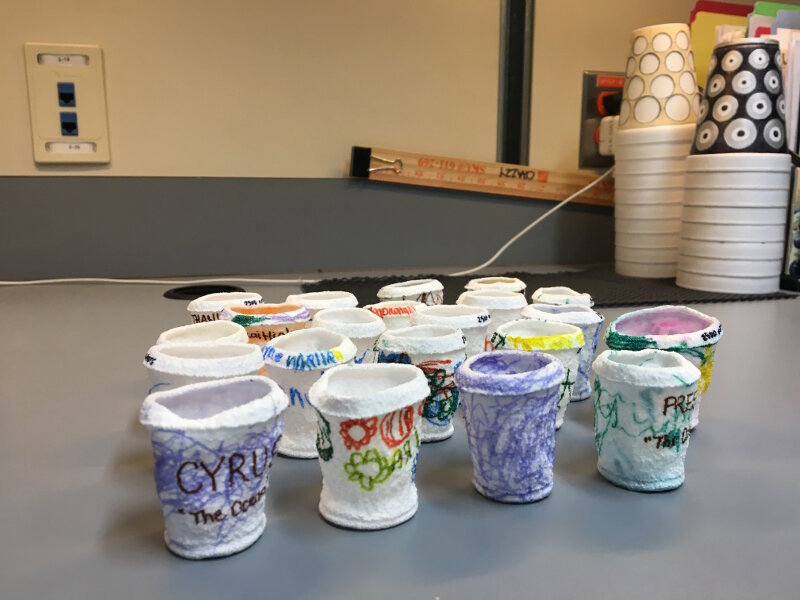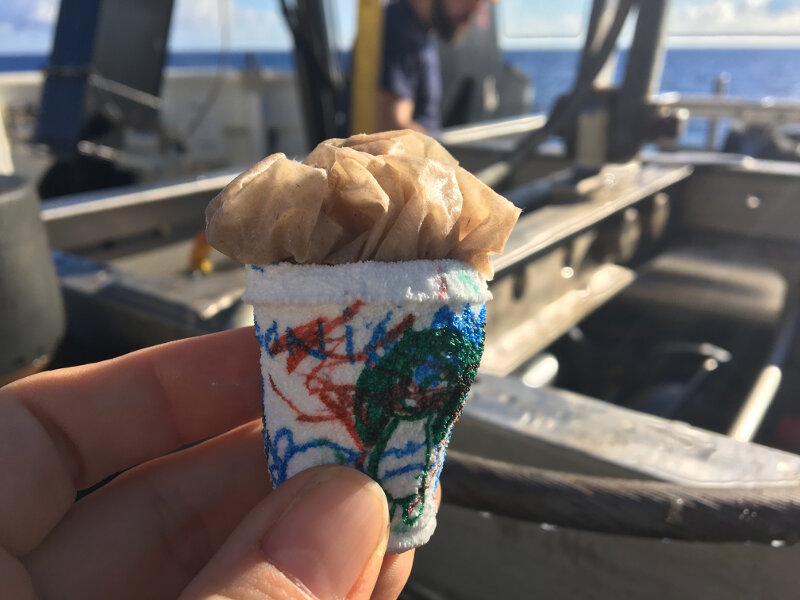
By Captain Mark Wetzler, Commanding Officer, NOAA Ship Okeanos Explorer
May 1, 2017

Stryofoam cups designed by the children E Malama I Na Keiki O Lanai Pre School in Lanai City, Hawaii, before being sent down to a depth of 2,500 meters during the second dive of this expedition. Image courtesy of the NOAA Office of Ocean Exploration and Research, Discovering the Deep: Exploring Remote Pacific MPAs. Download larger version (jpg, 1.3 MB).

The shrunken cups designed by the children E Malama I Na Keiki O Lanai Pre School in Lanai City, Hawaii, after visiting 2,500 meters deep attached to the ROV Seirios on Dive 02 of the expedition. Image courtesy of the NOAA Office of Ocean Exploration and Research, Discovering the Deep: Exploring Remote Pacific MPAs. Download larger version (jpg, 4.2 MB).
One of the traditions on an oceanographic cruise is to shrink Styrofoam cups which have been drawn on with a permanent marker. This is done by having the cups hitch a ride on a scientific instrument which is sent down into the deep ocean.
On NOAA Ship Okeanos Explorer, we have two instruments to which we can attach the cups: the Conductivity, Temperature, and Depth (CTD) instrument and the remotely operated vehicle (ROV) called Seirios, the companion vehicle to Deep Discoverer.
So the question is: why do the cups shrink when they take a trip down 1,000 or more meters deep?
The first part of the question is answered by looking at the construction of a Styrofoam cup. Technically, these cups are expanded polystyrene (plastic). Polystyrene is expanded by having a gas (air) injected into it. So the plastic is expanded by having little bubbles blown into it like bubbles in a bubble bath. When the cups are sent down to these extreme depths, the water pressure compresses the plastic, forcing all of the gas out.
So how much pressure is placed on a cup when it goes down into the deep ocean?
Let's start with an approximation of pressure first. Divers, when they talk pressure, speak in terms of an atmosphere. Every 10 meters of depth (approximately 33 feet) in seawater is one atmosphere. An atmosphere, by definition, is 14.7 pounds per square inch (psi).

Tucking a paper towel into a cup before its decent helps to ensure that it doesn't crumple in under pressure. Image courtesy of the NOAA Office of Ocean Exploration and Research, Discovering the Deep: Exploring Remote Pacific MPAs. Download larger version (jpg, 4.2 MB).
Therefore, if a Styrofoam cup were sent down 100 meters (nearly 330 feet), that would be 10 atmospheres of pressure (approximately 147 psi). At 1,000 meters (nearly 3,300 feet), that is 100 atmospheres (approximately 1,470 psi) of pressure. If we sent a Styrofoam cup to 6,000 meters (nearly 20,000 feet), the depth that our ROV can go, the cup would experience 600 atmospheres (8820 psi) of pressure! That is more than the weight of three midsized cars on a single square inch of space – like a postage stamp. Now that's a lot of pressure.
The amazing thing about this pressure is that it is uniform across the surface of the cup, so the cup does not crumble or deform. The Styrofoam cup shrinks uniformly as it is lowered into the ocean and the air bubbles are pressed out of it. However, to ensure it keeps its shape, we do put a crumpled paper towel inside.
Physicists have worked out the relationship between the depth and the pressure a liquid exerts at that depth. In Equation 1, p is pressure, ρ is the density of the liquid, h is the high of the liquid (in our case depth), and g is the local gravity. We are going to do the math using the International System of Units (SI). In SI, force is defined as a newton (N) or kg m/s2 and pressure is in Pascals (Pa) which is N/m2.
Equation 1: p = ρ g h
In the example below, we will calculate pressure at 6,000 meters. We are assuming that local gravity is 9.81m/s2, and that the density of seawater is 1029 kg/m3. Substituting the previous values into Equation 1, we get Equation 2.
Equation 2: p = 1029 kg/m3 * 9.81 m/s2 * 6000 m
Multiplying out and simplifying the units we get Equation 3.
Equation 3: p = 60,566,940 kg m2/m3s2 = 60,566,940 N/m2 = 60,566,940 Pa
Let's check the relationship between our calculated answer and our approximated answer. We can convert Pascals to atmospheres by the following relationship in Equation 4.
Equation 4: 1 Atmosphere = 14.7 lbs/inch2 = 101,325 Pa
Equation 5 converts Equation 3 to atmospheres.
Equation 5: p = 60,566,940 Pa = 60,566,940 Pa/101,325 Pa/Atmosphere = 597.749 Atmosphere
Converting the answer in Equation 5 to pounds per square inch, we find the pressure is 8,786.9 pounds per square inch. Our initial approximation of pressure, using a diver's rule of thumb for pressure, was 8,820 pounds per square inch. Our quick approximation was very close to the calculated answer.